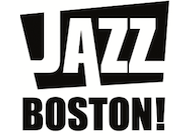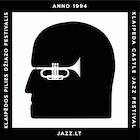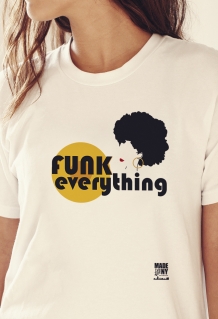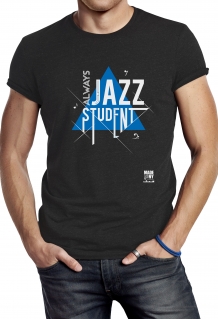New Book Covers First Half-Century of Swingin’ Sound in New York City
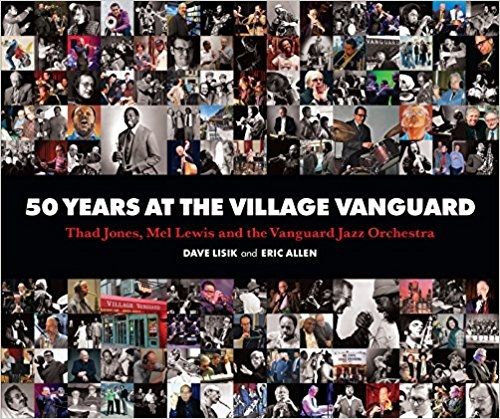
50 Years at the Village Vanguard: Thad Jones, Mel Lewis and the Vanguard Jazz Orchestra
by David Lisik and Eric Allen (2017, Skydeck Publishing)
A joyful onslaught of graphics, photos and posters; sidebars, indented quotes and other neat features add spark to this fascinating new book on the Vanguard Jazz Orchestra, making it an exciting journey for jazz lovers of all stripes. Readers can thumb through randomly and be assured of landing at place of interest: treating it as an encyclopedia, historical account, or a series of jazzy anecdotes that bring you shoulder-to-shoulder with the musicians of this iconic band.
Fifty years and hundreds of personalities is a lot of ground to cover. The authors achieve it with a light, sure hand; a conversational tone; and with wit and sass. Eric Allen talks about the work and the fun of it.
When did you first conceive of this book?
In the fall of 2015, I was talking to my co-author, Dave Lisik, about the fact that the band’s 50th anniversary was approaching. I said that somebody should put together a web site that featured the band’s history, personnel, discography, photos, etc.

Dave said, “Why just a web site? We should put together a book with all of that in it.” I was in the middle of finishing up another book project and thought there was no way I would have the energy to jump right into another project. I also thought that there might be too many moving parts and too many people that we would have to rely upon to get something like this done. But luckily, Dave was persistent and kept asking me until I agreed to do it.
What fascinates you about the VJO, and especially, Thad and Mel?
The first thing that always jumps out at me is the longevity of the band and how it has stayed vital and creative throughout its entire existence. More than fifty years of a steady gig, which is still thriving, is unheard of, especially in jazz.
Secondly, the length of time that some of the players have been part of the band is fascinating. John Mosca, the band’s director and lead trombonist, has been in the band over 42 years now. Dick Oatts, lead alto saxophonist and artistic director, just had his 40th anniversary with the band and Douglas Purviance, bass trombonist and business manager, is coming up on that same milestone this year. The entire saxophone section has been together more than 27 years and John Riley has now been the band’s drummer longer than Mel Lewis was. And none of these guys is just taking up space in the band. They’re all still playing great and all want to keep the band moving forward artistically. Nobody wants it to become a museum piece.
As far as Thad and Mel, I was surprised to find out just how highly regarded they were as musicians. Obviously, I knew that Mel was respected and was a good big band drummer, but many people talked about how he was one of the best drummers in the history of jazz. They also raved about what a master accompanist he was, both in the small group and big band settings, and how “easy” it was to play with him. I was also surprised to learn that he appeared on more than 600 recordings.
Similarly, I was familiar with Thad’s reputation as a writer, but was surprised to learn how respected he was as an improviser. Many people attested to the fact that, when Thad would solo with the band, they were absolutely transfixed and the word “genius” was used more than once to describe his improvising. Everybody said they wished Thad had soloed more with the band, but to his credit, he often gave up soloing opportunities so that others in the band had more chances to play and express themselves.
A few of the more fun facts you learned while writing this, about the VJO musicians’ personalities and their music?
It was pretty amusing to learn how opinionated, outspoken and outrageous Mel could be. He would always speak his mind and didn’t care what anybody thought about it. Dick Oatts and Earl Gardner have hilarious stories about meeting Mel for the first time, which are in the book. It was also interesting to learn that Thad was very much a “deadline” writer, meaning he would usually only write music if there was a recording session imminent or he had a commission due. Eddie Daniels told me that the band had a Tuesday morning recording session scheduled and Thad finished writing his arrangement of “The Groove Merchant” at the Village Vanguard after the Monday night gig with copyists looking over his shoulder as he composed.
What was the most surprising thing you learned about the Vanguard Jazz Orchestra?
I was surprised to learn that, right after Mel’s death, there was a pretty big philosophical debate about whether the band should become a “tribute band” at that point and just continue to play the music already in the books, or if it should forge its own identity and continue to innovate, while still keeping Thad and Mel’s music alive. Thankfully, they chose the latter path.
How would you characterize, in broad strokes, the different periods of the band throughout the decades?
Thad Jones/Mel Lewis Orchestra (1966-1978)
This is when Thad Jones was a co-leader, front man, featured soloist and primary writer for the band. While there are certainly other writers who contributed to the book, this period is overwhelmingly defined by the sound of Thad’s writing.

Mel Lewis and the Jazz Orchestra (1979-1990)
After Thad’s sudden departure in early 1979, Mel Lewis took over as the sole leader. One of the primary challenges he faced was finding new music for the band, as Thad was no longer writing for them. Mel convinced Bob Brookmeyer (one of the charter members of the orchestra and one of its early writers other than Thad) to become the band’s main writer and musical director, even though Brookmeyer hadn’t written anything in a decade. Brookmeyer contributed two amazing albums of innovative compositions and gave the band the new identity it needed as Mel took over on his own. Brookmeyer eventually pushed the envelope past what worked for Mel’s band and moved to Europe. For the rest of Mel’s tenure, a number of other writers started contributing to the book, including Jim McNeely, Michael Abene, Rich DeRosa, Ted Nash, Kenny Werner and others.
Vanguard Jazz Orchestra (1990-present)
After Mel’s death in 1990, the band became known as the Vanguard Jazz Orchestra. This period has mostly been defined by Jim McNeely’s tenure as Composer in Residence. Bob Brookmeyer also wrote a Grammy-nominated album of music for the VJO (“Over Time”), which was also the last album recorded of his music.
Did you find that that the growth, changes and evolution of the band reflected political and social changes in the country?
The diversity of the original band was fairly unique in the racially turbulent 1960’s. However, all of the original members I’ve spoken to say that it’s not something that they thought about at all back then. They were just wowed by all the great players in the band and Thad’s brilliant writing. But some of the subsequent members of the band have said that, growing up, that was something they definitely noticed and were inspired by; especially the fact that one leader was black, one was white and the band created such a happy and creative atmosphere.
What were some of the different sources of information you used? What special libraries, universities, catalogs or collections did you use?
By far, the most valuable and most fun resource was the archives at DownBeat magazine. Luckily, I happen to live about thirty minutes from their headquarters. I arranged to do a research session there, only intending to pull old issues that had interviews with Thad and Mel in them. While I was in the middle of that, DownBeat editor Frank Alkyer came to the table where I was working and set down two huge folders, one labeled “Thad Jones” and one labeled “Mel Lewis,” that were full of vintage photos. I ended up going back to DownBeat several more times. Everybody there was very kind, extremely helpful and the book wouldn’t have been nearly as good without their cooperation.
What do you think of Thad’s expressed desire to have the VJO act as the unofficial jazz band for New York City? Did he succeed?
Other than Thad saying that and the fact that, obviously, the band has always been known for its Monday night gig at the Village Vanguard, I don’t think that much ever really came from or was mentioned about this being the first noteworthy NYC-based big band. So much of what they did spread beyond NY that, in my opinion, it lessened the importance of that fact.
What big names got their start- or grew their careers- playing in this ensemble?
It’s difficult to say exactly where their careers were when they joined and left the band, or how much of an impact the band itself had in elevating their names, but musicians who were in the band and eventually went on to become big names in jazz include Eddie Daniels, Joe Farrell, Dee Dee Bridgewater, Jon Faddis, Rufus Reid, Joe Lovano, Gary Smulyan, Tom Harrell and Kenny Garrett.
Already-well-known players who spent time in the band include Snooky Young, Bob Brookmeyer, Richard Davis, Hank Jones, Pepper Adams, Frank Foster and Lew Soloff.
What was the biggest challenge overall to this project- the research, permissions, gathering of photos, writing, editing…etc.?
The biggest challenge was finding archival photos and interviews. We really had to dig to find most of what ended up in the book. After that, the biggest challenge was organizing the mountain of materials we had into a structure and narrative that made sense and was “reader-friendly.”
Rather than starting out and saying, “These are the chapters we want to present,” we gathered everything we could and covered as many different angles as we could in the interviews we conducted. Only after we had everything did we say, “Okay…now how do we want to organize this?” We let the information we gathered influence the structure of the book and I think that really helped us arrive at a format that feels very organic and makes a lot of sense.
How difficult was it to decide which art (photos, drawings, sheet music, notes etc.) was included?
Once we had decided what our chapters would be and completed the text for each one, we gave our designer, Ryan Olbrysh, all of the photos, images and sheet music we had that corresponded with that chapter. Sometimes, we would include a note like, “We want this photo to be really big” or “This one is important and for sure has to be included.” But, for the most part, he just took the all the raw materials we gave him and came up with a stunning presentation.
I would say that more than 95% of the time, the first design he would show us for a chapter ended up being the final product. Really, the only design elements that had to change were if the availability status of a photo had changed and we had to replace it with something else.
Pretty early on, we decided that we would also offer a PDF of bonus materials. We ended up with 361 pages of photos and other materials that didn’t end up in the book, so it wasn’t too hard to “let go” of something if it didn’t make it into the physical book.
Did you set out from the beginning to create your own imprint/label, or was that just the most expedient way to get it published?
At the very beginning, we contacted a publisher to see if they might be interested in the project, but didn’t get any sort of response at all. Then we realized that, if we did work with a publisher, we would lose a lot of creative control and probably lose the ability to use Ryan as our designer.
We didn’t want to risk a publisher wanting to cut costs and deciding which photos and images they wanted to pay for and which ones they didn’t. We decided the only way we could truly make this book exactly the way we wanted, and exactly the way it needed to be, was to do it ourselves.
Because of this, and the fact that Dave is a very active jazz composer and had a number of recording projects with some big-name players in the works that needed a record label, it made sense for us to start our own company, SkyDeck Music.
Anything like this book existing already?
Ours was the first book of its kind. Dave and I have talked several times about how fortunate we feel to be the first ones to put together a book like this about such a historically important big band, which also happens to be our favorite big band.
How did you meet your co-author?
Dave and I met in 1996 when we were both graduate teaching assistants in the jazz program at the University of Northern Iowa.
How did you divide the research and writing?
Because Dave lives in New Zealand, I had to do all of the archival research and coverage of the 50th anniversary event. And because of time differences, I conducted most of the phone interviews, but Dave did the hard part and transcribed most of those. I’ve jokingly apologized to him several times for having all of the fun of the research, the 50th anniversary week and the phone interviews to myself.
Once it was time to start writing, we each took half of the chapters and wrote a first draft. At that point, we worked together on Google Docs to do all of the editing. Any of his suggested changes were in purple text and any of my changes were in orange. We went back and forth and, once we both agreed on something and it was final, it was changed to black.
What do you most want people to know about this book?
Many readers have said that they’re blown away by all the photos and archival materials, but they are also learning a lot from the text. Achieving that kind of a balance between enjoyment and learning has been really satisfying.
When I stop to think about it, the fact that so many personalities, stories and all-time great jazz composers all share the common thread of this one band and the amazing gig at the Village Vanguard that has lasted more than half a century still boggles my mind. Hopefully, the book will inspire some people to become more familiar with the band’s rich discography and perhaps even make plans to go hear the band at the Vanguard.
For more information or to purchase the book (including access to limited-edition copies signed by the authors and the 361-page pdf containing bonus materials), visit www.skydeckmusic.com. This link offers free shipping and has a lower price than Amazon, where the book is also available.
Photos courtesy of and with permission of Eric Allen.
(c) Debbie Burke 2018
.jpg)
.jpg)
Debbie Burke is a jazz blogger who has interviewed hundreds of jazz musicians from around the globe. She is the author of “GLISSANDO: A story of love, lust and jazz” https://goo.gl/7hTJo5 and “The Poconos in B Flat.” Trained on alto sax at NYC’s New School for Social Research, she now spends her time as the editorial director for a small book publisher in Texas. Visit her blog at www.debbieburkeauthor.com



